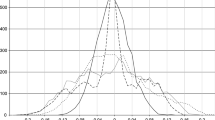Abstract
This note shows that the asymptotic properties of the quasi-maximum likelihood estimation for dynamic panel models can be easily derived by following the approach of Grassetti (Stat Methods Appl 20:221–240, 2011) to take the long difference to remove the time-invariant individual specific effects.
Similar content being viewed by others
References
Alvarez J, Arellano M (2003) The time series and cross-section asymptotics of dynamic panel data estimators. Econometrica 71:1121–1159
Anderson TW, Hsiao C (1981) Estimation of dynamic models with error components. J Am Stat Assoc 76:598–606
Anderson TW, Hsiao C (1982) Formulation and estimation of dynamic models using panel data. J Econom 18:47–82
Arellano M, Bond S (1991) Some tests of specification for panel data: Monte Carlo evidence and an application to employment equations. Rev Econ Stud 58:277–297
Arellano M, Bover O (1995) Another look at the instrumental variable estimation of error-components models. J Econom 68:29–51
Balestra P, Nerlove M (1966) Pooling cross-section and time series data in the estimation of a dynamic model: the demand for natural gas. Econometrica 34:585–612
Bond S (2002) Dynamic panel data models: a guide to micro data methods and practice. Port Econ J 1:141–162
Grassetti L (2011) A note on transformed likelihood approach in linear dynamic panel models. Stat Methods Appl 20:221–240
Hahn J, Hausman J, Kuersteiner G (2007) Long difference instrumental variables estimation for dynamic panel models with fixed effects. J Econom 140:574–617
Hsiao C (2014) Analysis of panel data. Cambridge University Press, Cambridge
Hsiao C, Pesaran MH, Tahmiscioglu AK (2002) Maximum likelihood estimation of fixed effects dynamic panel data models covering short time periods. J Econom 109:107–150
Hsiao C, Zhang J (2015) IV, GMM or likelihood approach to estimate dynamic panel models when either \(N\) or \(T\) or both are large. J Econom 187:312–322
Yamani H, Abdelmonem M (1997) The analytic inversion of any finite symmetric tridiagonal matrix. J Phys A Math Gen 30:2889–2893
Author information
Authors and Affiliations
Corresponding author
Additional information
We would like to thank M. H. Pesaran and K. Hayakawa for calling our attention to the Grassetti (2011) paper, two anonymous referees for helpful comments and suggestions. Partial research support of China NSF Grant #71131008 to the first author is gratefully acknowledged.
Appendix
Appendix
Since
and from (2.8),
The denominator of (6.1) is of the form
By continuous substitution, the first term on the right hand side of (6.2)
For the second term of the right hand side of (6.2), we note that for all i
with
then
as \(\left( N,T\right) \rightarrow \infty \). Combining (6.3) and (6.4) yields
as \(\left( N,T\right) \rightarrow \infty \).
For the limit of the numerator of (6.1), we note that
and
Combining (6.6) and (6.7) yields
This suggests that the MLE of \(\gamma \) is asymptotically unbiased either N or T or both tend to infinity.
Furthermore, under assumptions 1–2, the variance of the MLE \(\hat{\gamma }_{MLE}\) is given by
Rights and permissions
About this article
Cite this article
Hsiao, C., Zhou, Q. Asymptotic distribution of quasi-maximum likelihood estimation of dynamic panels using long difference transformation when both N and T are large. Stat Methods Appl 25, 675–683 (2016). https://doi.org/10.1007/s10260-016-0355-x
Accepted:
Published:
Issue Date:
DOI: https://doi.org/10.1007/s10260-016-0355-x




